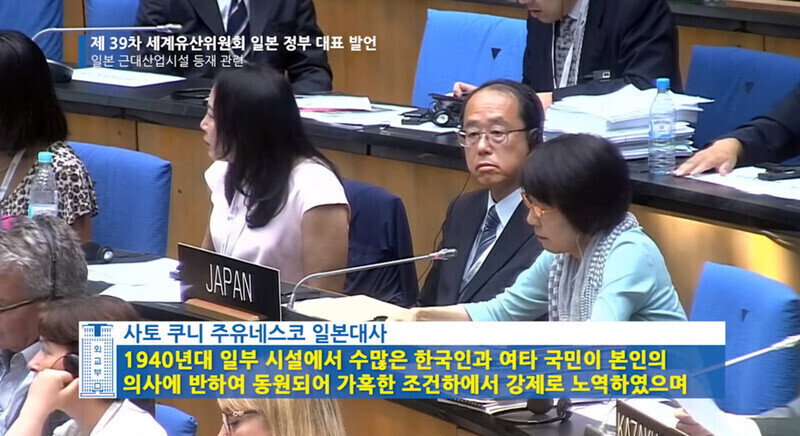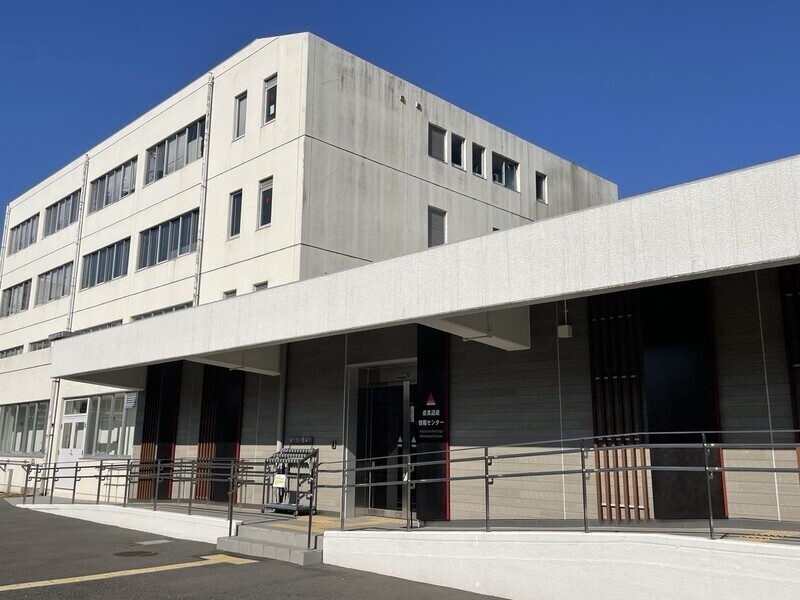hankyoreh
Links to other country sites 다른 나라 사이트 링크
[Reportage] Tokyo exhibit further distorts history of forced labor on Hashima amid silence from Seoul

On Wednesday, I paid a visit to Japan’s Industrial Heritage Information Center. Located in the annex on the first floor of the Japanese Ministry of Internal Affairs and Communications building in Shinjuku, Tokyo, the center was created after the Japanese government registered key locations of Japan’s industrialization during the Meiji period, such as Hashima Island, as World Heritage sites in 2015.
The Japanese government pledged it would allow for an understanding of the “full history” of each site. While the government should be widely promoting this facility, for some reason it has been kept under tight security, with visits requiring a reservation in advance for the past three years and no photos allowed inside.
The renewed attention to this exclusive facility comes after the UNESCO World Heritage Committee on Sept. 14 removed much of the criticism it had heaped on Japan two years ago in its decision on “follow-up measures” to be taken by the Japanese government regarding Hashima Island, also known as Gunkanjima or “Battleship Island,” a site of forced labor by Koreans.
In making this decision, the committee cited the fact that some of the exhibits at the center had changed. Hankyoreh visited the center on Wednesday to see what had changed and how.
The 1,078-square-meter Industrial Heritage Information Center is divided into three main exhibition areas. After passing through exhibits outlining Japan’s industrial heritage (Zone 1) and industrialization (Zone 2), there is a corner on Hashima Island, a site of much contention between South Korea and Japan over the past eight years.
In its statement, the World Heritage Committee praised the fact that there is now a place where visitors can read remarks made by the representatives of the Korean and Japanese governments during the World Heritage nomination process by scanning a QR code.

Scanning the QR code brought up a link to a video of the committee meeting in July 2015, when the listing of Hashima and other World Heritage sites was decided. Kuni Sato, Japan’s ambassador to UNESCO, and Choi Jong-moon, the Korean ambassador for cultural and UNESCO affairs, spoke in turn.
“Japan is prepared to take measures that allow an understanding that there were a large number of Koreans and others who were brought against their will and forced to work under harsh conditions in the 1940s at some of the sites, and that, during World War II, the government of Japan also implemented its policy of requisition,” Sato said in her remarks.
However, the statements were made in English, and the lack of Japanese subtitles raises questions of how well visitors would be able to understand the message the delegates were conveying.
UNESCO also recognized the newly installed TV monitor display titled “To Remember the Victims,” located directly next to the QR code. Based on a “security bulletin” and “security diary” created by the Hashima coal mine, it estimates that 44 people — 25 Japanese, 15 Koreans, and 4 others — died in collapsed mines on the island between November 1941 and November 1944.
The exhibition refers to the dangerous working conditions in coal mines at the time and emphasizes that Japanese and South Koreans faced the same hardships. The Japanese government had promised to take appropriate measures to honor the Korean victims who were forced to labor in harsh conditions against their will, but this has been changed to include all those who died in the mines.
In fact, exhibits have been added that rewrite history in a way that makes it appear that there was no discrimination against Koreans. There were a number of paycheck envelopes and salary records for Kim Tae-jo, a Korean laborer who had worked at the Harima Shipyard in Hyogo Prefecture between 1941 and 1945 after being forcibly mobilized.
At the exhibit, Kim’s highest take-home pay is recorded as 214 yen in April 1945, which is accompanied by a note that says, “For reference, at the time, the basic salary for young bureaucrats who passed Imperial Japan’s Higher Civil Service Examinations was 75 to 100 yen” — essentially claiming that Korean laborers were treated as well as elite Japanese civil servants.

How much of this is “substantial truth” will require investigation, but the fact is that Harima Shipyard isn’t even on the list of 23 modern Japanese industrial facilities listed as UNESCO World Heritage sites.
This is the same as claiming that the labor conditions of a particular company were stellar while flaunting a paycheck from a completely different workplace.
As I walked through the exhibit, there was very little information about the horrific history of forced labor, harsh working conditions, and extreme discrimination that Korean victims of forced labor experienced on Hashima Island.
Pieces that appeared to deny this history were displayed in the most prominent locations of the exhibition. A testimony from Sakae Matsumoto, the honorary chairman for the Hashima Islanders for Historical Truth, is on display, reading, “On Hashima, no one made any distinction between Koreans or Chinese, or anyone else. We all needed to bond together to complete our jobs.”
A testimony from Fumio Suzuki, a Zainichi Korean, expressed feeling “beloved” and cared for by those around him on Hashima, seemingly denying that there was any discrimination against or ill treatment of Koreans.
Also noticeable was some content critical of Sato’s remarks. One exhibit entitled “Gunkanjima Is Our Home” responded to the Japanese UNESCO ambassador’s 2015 comments by suggesting there was “too little effort by the Japanese government to accurately refute them.”
One of the reasons that UNESCO positively rated Japan’s efforts despite the changes for the worse in terms of exhibition content is that the Yoon Suk-yeol administration in South Korea has not made diplomatic efforts to correct Japan’s historical distortions — instead maintaining an approach of making unilateral concessions on historical issues and other sensitive matters.
During his predecessor Moon Jae-in’s administration, not only the Ministry of Foreign Affairs but even the Ministry of Culture, Sports and Tourism adopted an adamant stance in attempting to steer changes in Japan’s attitude.
Amid the new South Korean government’s hands-off approach, Japan invited UNESCO officials to Tokyo twice — in January and August of this year — to actively explain what they were working to achieve.
Commenting on the latest decision in an appearance on Japan’s NHK network, an unnamed UNESCO source said that “recently improving relations between Japan and South Korea had given momentum to the adoption of the resolution.”
According to sources, Japan did not consult closely with South Korea on the changes in exhibition content. In effect, South Korea was stuck helplessly observing the developments from the sidelines.
An official with Seoul’s Foreign Ministry said that Japan had “begun taking action to honor its pledge,” adding that Seoul would “continue demanding that things like testimony about forced labor [by Koreans] be included.”
By Kim So-youn, Tokyo correspondent
Please direct questions or comments to [english@hani.co.kr]

Editorial・opinion
![[Editorial] Intensifying US-China rivalry means Seoul must address uncertainty with Beijing sooner than later [Editorial] Intensifying US-China rivalry means Seoul must address uncertainty with Beijing sooner than later](https://flexible.img.hani.co.kr/flexible/normal/500/300/imgdb/original/2024/0517/8117159322045222.jpg) [Editorial] Intensifying US-China rivalry means Seoul must address uncertainty with Beijing sooner than later
[Editorial] Intensifying US-China rivalry means Seoul must address uncertainty with Beijing sooner than later![[Column] When ‘fairness’ means hate and violence [Column] When ‘fairness’ means hate and violence](https://flexible.img.hani.co.kr/flexible/normal/500/300/imgdb/original/2024/0516/7417158465908824.jpg) [Column] When ‘fairness’ means hate and violence
[Column] When ‘fairness’ means hate and violence- [Editorial] Yoon must stop abusing authority to shield himself from investigation
- [Column] US troop withdrawal from Korea could be the Acheson Line all over
- [Column] How to win back readers who’ve turned to YouTube for news
- [Column] Welcome to the president’s pity party
- [Editorial] Korea must respond firmly to Japan’s attempt to usurp Line
- [Editorial] Transfers of prosecutors investigating Korea’s first lady send chilling message
- [Column] Will Seoul’s ties with Moscow really recover on their own?
- [Column] Samsung’s ‘lost decade’ and Lee Jae-yong’s mismatched chopsticks
Most viewed articles
- 1[Editorial] Transfers of prosecutors investigating Korea’s first lady send chilling message
- 2[Exclusive] Unearthed memo suggests Gwangju Uprising missing may have been cremated
- 3S. Korea “monitoring developments” after report of secret Chinese police station in Seoul
- 4[Editorial] Intensifying US-China rivalry means Seoul must address uncertainty with Beijing sooner t
- 5Could Korea’s Naver lose control of Line to Japan?
- 6Korea cedes No. 1 spot in overall shipbuilding competitiveness to China
- 7[Column] US troop withdrawal from Korea could be the Acheson Line all over
- 8China, Russia put foot down on US moves in Asia, ratchet up solidarity with N. Korea
- 9Xi, Putin ‘oppose acts of military intimidation’ against N. Korea by US in joint statement
- 10Korea’s first openly trans athlete hopes to prompt a discussion by competing as herself